Five Reasons Why It Is Still Worth Investing in Crypto After the Bitcoin Halving
The Bitcoin mining reward halving that took place earlier this year was one of the most anticipated events in the Bitcoin lifecycle. This is the third time this halving has occurred, and it has had big ramifications in the past, and equally expected to have ramifications going forward.
At its basis, the halving is an event that impacts the mining of the cryptocurrency, but as is known in the Bitcoin ecosystem there are strong links between the different sectors and the health and well-being of the mining sector and its impact on the network often leads to changes in the market and the price of the coin.

The latest Bitcoin mining reward halving took the reward for unlocking a new block on the Bitcoin blockchain from 12.5 BTC to 6.25 BTC. This subtle change has big implications that affect mining profitability and difficulty, as well as — for investors — volatility, scarcity, the inflation model, adoption, and designation of Bitcoin.
These five aspects are also five good reasons that make Bitcoin still a very worthwhile asset to invest in following this major occurrence.
Volatility
Bitcoin has always been famed for its volatility, and while this is a double-edged sword because it can lead to risk in investing, it is also one of the reasons why investors have flocked to the Bitcoin market.
Part of the reason that Bitcoin is so volatile is that it is also such a speculative investment, and that means it often moves in great swings depending on the news and rumours surrounding it.

The halving event has, for the 18 or so months preceding it, been seen mostly as a positive for the Bitcoin market for a number of reasons, this prediction and rumour alone has helped the price of the coin rise up, and as such, increase the volatility making it a prized investable asset for a number of investment strategies.
Scarcity
One of the more practical implications of the halving is that there are now 50% fewer new coins coming into the circulating supply. It is well known that there are only 21 million Bitcoins that will ever exist, but the number being mined and available is 50% less, meaning that there is a higher degree of scarcity.
Basic macroeconomics dictates that with higher scarcity comes lower supply, and with lower supply, there is higher demand. Higher demand leads to an increase in the price of an asset, and this halving in Bitcoin should thus lead to higher prices — especially when teamed with an increase in adoption.
Deflationary
More economics, but the halving event and its impact on the incoming supply of Bitcoin means that the stock-to-flow (SF) ratio is on the rise. The SF ratio quantifies the scarcity of an asset, measured by dividing an asset’s total circulating supply (stock) by the amount produced annually (flow).
The SF of Bitcoin pre the halving is 27.55, but after the halving, it will jump above 50 to sit at 55.94. This aligns it much more with gold than a fiat currency, and. It also means that the coin is becoming more deflationary. Bitcoin’s inflation rate was around 3.6% before the halving and went down to 1.8% after the event. This means it is now lower than the average inflation target central banks reference worldwide at 2%.
Adoption
This is the third time that Bitcoin has undergone a halving, and the evidence from the other two also points towards a better market down the road and a good time to invest, But more than that, Bitcoin has changed a lot since the first and second halving events.

In 2017, the coin really hit the mainstream news and was propelled to huge heights in terms of market price, topping out at $20,000. Since then, there has been an up and down in the market price, but the adoption, legitimisation, and normalisation of Bitcoin and the cryptocurrency space has kept going up .
Adoption is still rising, and the space after the halving is showing interest in adoption from other sectors — especially in terms of institutional interest. Grayscale Bitcoin Trust has purchased more than 1.5 times the number of Bitcoins mined since this third halving for its Bitcoin trust.
Designation
Bitcoin has also been pushing the narrative that it is more of a digital gold than a workable currency, and amid the COVID-19 pandemic and the market collapse, it has shown signs of being a safe haven and a good investment asset.
This has been the case for Bitcoin for some time now, heading towards a designation of an investable asset rather than a currency, but the halving has only further propelled this with its change in inflation percentage and its stock-flow ratio.
 Best Time Since the Last Time
The saying goes that the best time to invest was yesterday, and the next best time is today. The same rings true with Bitcoin at the moment. Many think they have missed out by not getting in early in 2017, but this is not true.
Bitcoin is in a better place in terms of investing today as there are a number of new and established ways to invest, such as margin trading. There are a number of major crypto-based exchanges such as Binance, Overbit, and Deribit that also offer commodities and other traditional trading opportunities.
Bitcoin is in an interesting place in its market path, the cryptocurrency is still seen as heavily undervalued, and because of its speculative nature, an occurrence like a halving could impact its future price greatly and make this a very good time to get into the market before the implications of the halving take effect.



